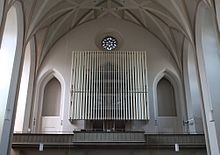New parish church St. Johann Baptist (Haidhausen)
The St. Johann Baptist is a parish church in the Munich district of Haidhausen . It was built between 1852 and 1874 according to plans by Matthias Berger on Johannisplatz in neo -Gothic style. Its west tower is about 91 m high, making it the sixth highest church in Munich.
Construction and war damage
As early as the early and middle of the 19th century, the population in and around Munich rose sharply on both sides of the Isar. The old church in the village of Haidhausen soon became too small. That is why the building of a new and larger church was propagated for years, but only started under Pastor Johann Georg Walser (1848–1871) and made possible through his 29 begging trips, including to the court of Emperor Franz Joseph in Vienna. The architect was Matthias Berger (1825-97), a student of Friedrich Gärtner. The construction progress was based on the receipt of the money, not only from donations, but also from grants from the city of Munich, into which Haidhausen was incorporated in 1854. In 1863 the shell with the then 99 m high west tower was completed, and the tower cross was unveiled on October 12th. In 1874 the church was essentially completed inside and outside, but could not be consecrated because the city of Munich wanted to hold the church in front of the Old Catholics, who had split off in the First Vatican Council, because of their grants; but they did not multiply as much as had been suspected. On August 24, 1879, the day before the name day of the reigning King Ludwig II, the church was consecrated by Archbishop Antonius von Steichele.
The church was hardly damaged in World War II; only the replacement windows for the 21 glass paintings that had been removed as a precaution in January 1943 and kept in the district of Erding were, as expected, broken in a bombing raid in October of the same year. Probably loosened by several explosive bombs in the area, but a vault rib fell down in 1949 and killed the church keeper Huber. The fact that, as a precaution, all the ribs were chopped off in 1951, unintentionally gave the starting signal for the coming “purification” of the church inside (1956) and then outside until around 1969. The main tower received a new pointed helmet in 1967 with a smooth wooden construction and is only 91st m high; The side towers were later given smaller spikes in a similar shape.
Six bells hang in the tower in the striking sequence b 0 –c 1 –d 1 –f 1 –g 1 –b 1 . The small bronze bell from 1869 (Bachmair bell foundry) was supplemented in 1948 by five cast steel bells in the so-called "V-12 rib" of the Bochum association . On Fridays at 3 p.m. the big bell rings in memory of the hour of Christ's death. This also rings daily for the midday angel at noon. Sunday starts at 3 p.m. on Saturday.
Structure
The west tower characterizes the district with its 91 m today. The church is about 80 m long, 35 m wide and about 40 m high on the outside; the east towers are about 60 m. The church is built entirely from Haidhauser bricks, which originally received a terracotta cladding at the will of King Max II. this can still be seen on the sides and on the choir. On the west facade, it was completely removed during the renovation work in order not to make the repaired areas too conspicuous: this was given up for later work. The interior, 27 m high, is a hall with pillars, which is rarely found in Gothic; if you forget the Spitzbogem, you could think of Upper Bavarian baroque churches, e.g. B. Dietramszell, be remembered. During the last renovation in 1978, the vault ribs were painted again by Peter Burkart . The neo-Gothic furnishings are only preserved in the marble high altar by Joseph Knabl , the side altars and the communion bench. The chalice-shaped folk altar, the ambo and the altar candlesticks were created by Carola Heinen in 1998.
Max Reger organ
The organ of St. Johann Baptist was built in 2005 by the organ building company Hartwig Späth (Freiburg). The instrument has 46 stops on three manuals and a pedal and hangs on the back wall of the west gallery. The modern design of the brochure , which enables a direct view of the inside of the factory, is striking . The side walls and the game table are made of glass. The dedication as a Max Reger organ goes back to the fact that Max Reger lived in Haidhausen and played the organ in the parish church on Johannisplatz.
|
|
|
|
||||||||||||||||||||||||||||||||||||||||||||||||||||||||||||||||||||||||||||||||||||||||||||||||||||||||||||||||||||||||||||||||||||||||||||||||||||||
-
Pairing :
- Normal coupling: III / I, II / I, III / II, I / P, II / P, III / P
- Super octave coupling: III / III
- Sub-octave coupling: III / III
- Playing aids : 10,000-fold typesetting system , register crescendo
literature
- Pastor Leibiger: The churches of the parish St. Johann Baptist. Munich-Haidhausen . Schnell and Steiner, Regensburg 2008, ISBN 978-3-7954-5105-9 (series: Small art guides / churches and monasteries).
Individual evidence
- ^ Stefan Ludwig: Our organ landscape. In: pfarrverband-haidhausen.de. Retrieved March 2, 2018 .
Web links
Coordinates: 48 ° 8 ′ 2 " N , 11 ° 35 ′ 52" E




